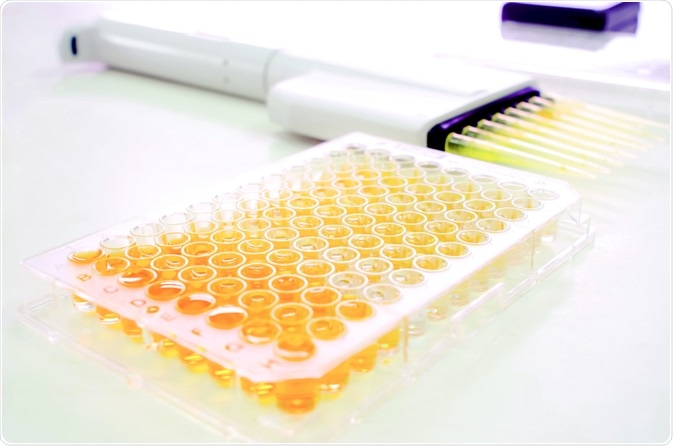High-throughput screening (HTS) allows scientists to test thousands of samples simultaneously. These samples can be of a wide variety, and include, but are not limited to, amino acids, chemical compounds or cells.
 Image Credit: Choksawatdikorn / Shutterstock
Image Credit: Choksawatdikorn / Shutterstock
The most common sample vessel used in HTS is the microtiter plate, containing many wells (385, 1536, or 3456). The samples are each placed within the wells and treated before measurements are taken. These measurements can be either manual (e.g. microscopy) or mechanical (e.g. reflectivity). When using a machine, the measurement process is rapid and high-throughput.
What is hit selection?
One of the main goals of HTS is to be able to select compounds with required size of inhibition and activation effects. A hit is a compound that matches these properties, usually, around 2% of all compounds treated.
By identifying which compounds match these properties, they can undergo secondary analysis, allowing for more information to be gathered. Therefore, in hit selection, analytic methods are utilized to identify compounds with desirable properties, sorting through lots and lots of data to identify significance. The fold change, mean difference, percent activity, percent viability, and percent inhibition can be evaluated.
Hit selection methods
The best compounds (aka hits) can be identified through two different mechanisms, which are either by the ranking and classification of compound properties or by testing each compound individually to detect those that reach the desired level. Furthermore, there are two types of screens in HTS, those without replicates or those with replicates.
The number of replicates influences the analytical evaluation of their results. Those without multiple results utilize z-scores to indicate significance, whereas those with multiple data sets can use t-statistic to indicate significance.
In screens without replicates, the z-score method is utilized, which relies on the results having a normal distribution. Therefore, it can be very susceptible to outliers.
The variability of the data is estimated through the strictly standardized mean difference (SSMD), which also quantifies the size of the effect. In screens with replicates, the variability can be calculated directly from the data, which means that it is much more accurate. A t-test can then be used to calculate the significance and highlight hits.
Hit confirmation
Once a hit is identified, it is then confirmed through further testing. This is through a variety of methods, such as confirmatory testing, the formation of dose-response curve, secondary screening, orthogonal testing, biophysical testing, and other methods.
Hits in drug development
In the case of drug development, once the size of the drug effect is confirmed through hit selection, the compound can then be further evaluated for drug like properties and optimised to maximise therapeutic potential.
In this process, the researcher ensures that the compound has a suitable range of traits. They therefore monitor the cytotoxicity, stability, permeability, efficiency, affinity, (etc.), of the drug.
Further Reading